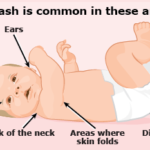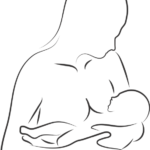Cradle Cap or crib cap is a noninflammatory skin condition of the scalp in infants. Besides the scalp, it may also affect the face, diaper area, and skin folds. It is a type of seborrheic dermatitis seen in infants. Read more about Seborrheic Dermatitis- Clinical Features, Causes, and Treatment Cradle cap commonly affects infants within […]
Child Health
Breastfeeding – Benefits, Problems and Tips for Better Feeding
Breastfeeding or lactation is a natural and normal way of providing newborns and infants with all the nutrients they need. It is the purest, safest and most sustainable way to feed an infant. Since it offers so many benefits to both the mother and the child, it is recommended that babies should be exclusively breastfed […]
Omphalitis – Causes, Presentation and Treatment
Omphalitis is an infection of the umbilicus and/or surrounding tissues, occurring primarily in the neonatal period. It is a true medical emergency that can rapidly progress to systemic infection and death. The estimated mortality is between 7% and 15%. Early recognition and treatment are essential to prevent the morbidity and mortality associated with omphalitis. Omphalitis […]
Penile Agenesis or Aphalia – Presentation and Treatment
Penile agenesis or aphallia means an absence of formation of the penis. It is a rare condition occurring in 1 in 30 million births and results from a development failure of the genital tubercle during the fourth week of embryogenesis. The genital tubercle is the embryonic progenitor mesenchymal tissue forming penis in man and clitoris […]
Acrodynia or Pink Disease-Symptoms and Treatment
Acrodynia is a condition that primarily affects young children and is characterized by pink discoloration of the hands and feet, irritability, photophobia (sensitivity to light) and polyneuritis (inflamed nerves). The symptoms are often caused by chronic mercury exposure. Acrodynia was common in the past when the use of mercury-containing preparations was common. It is rarely […]
Umbilical Artery Catheter – Indications and Procedure
Umbilical artery catheter insertion is a common procedure used in intensive care of neonates. It is considered the standard of care for arterial access in neonates. The umbilical artery can be used for arterial access during the first 5-7 days of life [rarely beyond 7-10 days.] It allows direct access to the arterial blood supply […]
Do and Don’ts of Fever in Children – NICE Guidelines
In 2007 British journal of clinical practice published NICE guidelines on fever. It contains practical advice on fever care. Here is the set of guidelines Use of Antipyretic Agents These guidelines recommend agains use of antipyretic agents routinely with the sole aim of reducing body temperature in children with fever who are otherwise well. So […]
Hemolytic Disease of Newborn
Hemolytic disease of the newborn is a condition that develops in a fetus, when the maternal antibodies pass through the placenta and attack antigens on the red blood cells in the fetal circulation, breaking down and destroying the cells. The condition of the fetus could be from mild to very severe, and fetal death from […]
Twin to Twin Transfusion Syndrome
Twin to twin transfusion syndrome is a condition in which intrauterine blood transfusion occurs from one twin to other, resulting in anemic donor twin and plethoric recipient with hemoglobin differences greater than 5 g/dL. The donor twin is often smaller with a birth weight 20% less than the recipient’s birth weight. Twin to twin transfusion […]
Morquio Syndrome or Mucopolysaccharidosis IV
What is Morquio Syndrome? Morquio syndrome is a familial variety of osseous dystrophy involving bones developed from cartilage that result in dwarfism, spine deformity and joint deformities with typical radiological changes in the vertebral bodies and limb bones but without the hepatosplenomegaly and mental deterioration seen in Hurler’s syndrome and without early corneal changes. Inheritance […]










